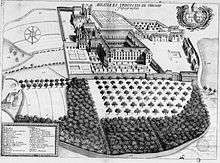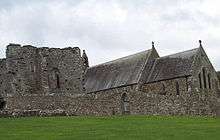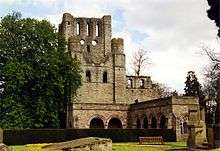Tironensian Order
The Tironensian Order or the Order of Tiron was a Roman Catholic monastic order named after the location of the mother abbey (Tiron Abbey, French: Abbaye de la Sainte-Trinité de Tiron, established in 1109) in the woods of Tiron (sometimes Thiron) in Perche, some 35 miles west of Chartres in France).[lower-alpha 1] They were nicknamed "Grey Monks" because of their grey robes, which their spiritual cousins, the monks of Savigny, also wore.
History

Founder
The order, or congregation, of Tiron was founded in about 1106 by the Benedictine Bernard de Ponthieu, also known as Bernard d'Abbeville (1046–1117), born in a small village near Abbeville, Ponthieu.
Tonsured at the Benedictine Abbey of Saint-Cyprien in Poitiers around the year 1070, Bernard left the order in 1101 when his nomination as abbot of Saint-Savin-sur-Gartempe was disapproved by Cluny and Pope Paschal II. From then on Bernard lived first as a hermit on the island of Chausey, between Jersey and Saint-Malo, then in the woods of Craon, near Angers, with two other rigorist monks: Robert d'Arbrissel, future founder of the controversial Abbey of Fontevraud, and Vitalis de Mortain, later the founder of the Congregation of Savigny in 1113. Following the example of the Desert Fathers, all three men and their followers (men and women) lived detached from the world, in great poverty and strict penance.
Followers of Bernard of Thiron
| Saint Adelelmus | |
|---|---|
|
Statue of St. Adelelmus in the Monastery of Etival-en-Charnie | |
| Born | Flanders, Belgium |
| Died | 1152 |
| Venerated in | Roman Catholic Church |
| Feast | 27 April |
Adelelmus was a hermit and disciple of St. Bernard of Thiron. Born in Flanders, Belgium, Aldelelmus is best known for founding the Monastery of Etival-en-Charnie.[2]
Tiron Abbey
The foundation of Tiron Abbey by Bernard of Abbeville was part of wider movements of monastic reform in Europe in the eleventh and twelfth centuries.[3] As a pre-Cistercian reformer, Bernard's intention was to restore the asceticism and strict observance of the Rule of St. Benedict in monastic life, insisting on manual labour. He founded his monastery on land in Thiron-Gardais granted to him by Bishop Ivo of Chartres,[4] and placed it under the protection of the cathedral canons of Chartres, instead of a secular overlord. This assured that decisions affecting the Abbey were made by a corporate religious body.
Bernard admitted artisans and encourage them to produce goods for sale. During years of famine, Tiron endured great poverty and became a refugee camp and soup kitchen. During the famine of 1109–1111 the Abbey sheltered whole families. Tiron had a school; and after Bernard's death, built houses so that lay women could reside within its walls under the care and protection of the monks.[3]
Tironensian Order
Tiron was the first of the new religious orders to spread internationally.[5] Within less than five years of its creation, the Order of Tiron owned 117 priories and abbeys in France, England, Wales, Scotland and Ireland.

In 1113 Robert FitzMartin granted the Tironensians land and money to found the order's first house in Wales, St Dogmaels, Pembrokeshire, which was established on the site of a clas (early Celtic church), which dated back to at least 600 AD. Closed during the Dissolution of the monasteries, much of the stone was quarried for other uses.[6]

In Scotland, the Tironensians were the monks and master craftsmen who built and occupied (until the Reformation) the abbeys of Selkirk (later re-located to Kelso (1128), Arbroath (1178), Kilwinning (1140+), and Lindores Abbey, Newburgh, Fife. The first two abbots of Selkirk became, in turn, abbots at Tiron. During the tenure of William of Poitiers as abbot, Tiron established abbeys and priories along the north-south trade routes from Chartres to the navigable Seine and Loire rivers. Under him, the abbey owned at least one ship that traded in Scotland and Northumberland.[3] Tiron adopted a system of annual general chapters. In 1120, Abbot William decreed that abbots from overseas need only attend once in every three years. Arnold, Abbot of Kelso, founded the cathedral church at St. Andrews.[7] In France, the order was integrated into the new Benedictine Congregation of St. Maur in 1627.
See also
References
Notes
Citations
- ↑ Guillemin (1999)
- ↑ Catholic Online. "St. Adelelmus – Saints & Angels – Catholic Online". Catholic.org. Retrieved 2013-12-10.
- 1 2 3 Geoffrey Grossus The Life of Blessed Bernard of Tiron, (Ruth Harwood Cline, trans.), The Catholic University of America Press, (2009)
- ↑ "S. Bernard and his Foundation", The Benedictines of Caldey, The Abbey, Isle of Caldey, 1912
- ↑ "Tironensian", Monastic Wales
- ↑ "St Dogmaels Abbey's influence remains after 900 years", BBC News south West Wales, March 31, 2013
- ↑ Barrow, G.W.S., The Kingdom of the Scots, Edinburgh University Press, 2003 ISBN 9780748618033
Bibliography
- Guillemin, Denis (1999), Thiron, Abbaye médiévale, Amis du Perche
Further reading
- Bulletin de la Société archéologique d'Eure-et-Loir, Spécial Inventaire Monumental, Édifices religieux du Canton de Thiron-Gardais, No 30, 3e trimestre 1991
- Dom Jacques de Bascher, La Vita de saint Bernard d'Abbeville, abbé de Saint-Cyprien de Poitiers et de Tiron, Revue Mabillon No 278, 1979
External links
| Wikimedia Commons has media related to Abbaye de la Sainte-Trinité (Tiron). |
- Official site of Thiron-Gardais (France), section Histoire
- Site of the Abbaye Cistercienne du Mont des Cats (France, section Histoire bénédictine
Coordinates: 48°18′43″N 0°59′37″E / 48.31194°N 0.99361°E